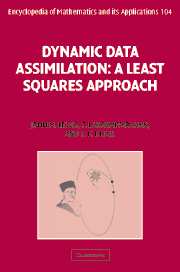Book contents
- Frontmatter
- Contents
- Preface
- Acknowledgements
- PART 1 GENESIS OF DATA ASSIMILATION
- PART II DATA ASSIMILATION: DETERMINISTIC/STATIC MODELS
- PART III COMPUTATIONAL TECHNIQUES
- PART IV STATISTICAL ESTIMATION
- PART V DATA ASSIMILATION: STOCHASTIC/STATIC MODELS
- 18 Data assimilation – static models: concepts and formulation
- 19 Classical algorithms for data assimilation
- 20 3DVAR: a Bayesian formulation
- 21 Spatial digital filters
- PART VI DATA ASSIMILATION: DETERMINISTIC/DYNAMIC MODELS
- PART VII DATA ASSIMILATION: STOCHASTIC/DYNAMIC MODELS
- PART VIII PREDICTABILITY
- Epilogue
- References
- Index
21 - Spatial digital filters
from PART V - DATA ASSIMILATION: STOCHASTIC/STATIC MODELS
Published online by Cambridge University Press: 18 December 2009
- Frontmatter
- Contents
- Preface
- Acknowledgements
- PART 1 GENESIS OF DATA ASSIMILATION
- PART II DATA ASSIMILATION: DETERMINISTIC/STATIC MODELS
- PART III COMPUTATIONAL TECHNIQUES
- PART IV STATISTICAL ESTIMATION
- PART V DATA ASSIMILATION: STOCHASTIC/STATIC MODELS
- 18 Data assimilation – static models: concepts and formulation
- 19 Classical algorithms for data assimilation
- 20 3DVAR: a Bayesian formulation
- 21 Spatial digital filters
- PART VI DATA ASSIMILATION: DETERMINISTIC/DYNAMIC MODELS
- PART VII DATA ASSIMILATION: STOCHASTIC/DYNAMIC MODELS
- PART VIII PREDICTABILITY
- Epilogue
- References
- Index
Summary
In this chapter we provide an overview of the role and use of spatial digital filters in solving the retrieval problem of interest in this part V. This chapter begins with a classification of filters in Section 21.1. Nonrecursive filters are covered in Section 21.2 and a detailed account of the recursive filters and their use is covered in Section 21.3.
Filters: A Classification
The word filter in spatial digital filter is used in the same (functional) sense as used in coffee filter, water filter, filter lenses, to name a few, that is, to prevent the passage of some unwanted items – the coffee bean sediments from the concoction, impurities in the drinking water, a light of particular wavelength or color from passing through. Spatial filters are designed to prevent the passage of signal components of a specified frequency or wavelength. For example, the low-pass filter is designed to suppress or filter out high frequency or smaller wavelength signals. There is a vast corpus of literature dealing with filters in general. In this section we provide a useful classification of these filters.
Filters can be classified along at least five different dimensions depending on the type of signals and the properties of the filter. Refer to Figure 21.1.1. Signals to be filtered can be in analog or digital form and signals can be a function of time and/or space. For example, in time series modelling we deal with digital signals in discrete time and analog computers use continuous time signals.
- Type
- Chapter
- Information
- Dynamic Data AssimilationA Least Squares Approach, pp. 340 - 362Publisher: Cambridge University PressPrint publication year: 2006

